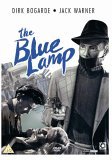![Harvey [1950]](/pictures/1012339.jpg) Harvey | DVD | (18/08/2003)
from £6.59
| Saving you £3.40 (51.59%)
| RRP
Harvey | DVD | (18/08/2003)
from £6.59
| Saving you £3.40 (51.59%)
| RRP It's always a small surprise to revisit this movie and realise what a subtly dark performance James Stewart gives as an alcoholic who claims he keeps company with a six-foot-tall, invisible rabbit. As Elwood P. Dowd, the actor emits a faint whiff of decay and spirits, yet Stewart also embraces Dowd's romanticism and grace with splendid ease. Based on a hit play and directed by Henry Koster, the film is terribly funny at times, especially whenever Elwood decides it is only polite to introduce Harvey to complete strangers. The supporting cast can't be beat. --Tom Keogh
![Jeepers Creepers [2001]](/pictures/1022811.jpg) Jeepers Creepers | DVD | (01/04/2002)
from £6.17
| Saving you £7.82 (126.74%)
| RRP
Jeepers Creepers | DVD | (01/04/2002)
from £6.17
| Saving you £7.82 (126.74%)
| RRP Returning home from a game, a group of varsity basketball players, cheerleaders, and coaches become stranded on the infamous East 9 Highway and must fight a winged nightmare bent upon feasting on human flesh.
![Jeepers Creepers Collection [DVD]](/pictures/1145707.jpg) Jeepers Creepers Collection | DVD | (29/12/2017)
from £N/A
| Saving you £N/A (N/A%)
| RRP
Jeepers Creepers Collection | DVD | (29/12/2017)
from £N/A
| Saving you £N/A (N/A%)
| RRP Taking place on the last day of the Creeper's twenty-three-day feeding frenzy, as the skeptical Sargent Tubbs teams up with a task force hellbent on destroying the Creeper for good. The Creeper fights back in gory glory as its enemies grow closer than ever before to learning the secret of its dark origins.
 The Blue Lamp | DVD | (21/08/2006)
from £18.70
| Saving you £-5.71 (N/A%)
| RRP
The Blue Lamp | DVD | (21/08/2006)
from £18.70
| Saving you £-5.71 (N/A%)
| RRP The unending battle of the city streets. When PC George Dixon is shot whilst on duty the Paddington Green police investigate the West London underworld to bring the culprit to justice...
![Blue Lamp, The / The Nanny [1965]](/pictures/1012436.jpg) Blue Lamp, The / The Nanny | DVD | (23/06/2003)
from £14.99
| Saving you £1.00 (6.67%)
| RRP
Blue Lamp, The / The Nanny | DVD | (23/06/2003)
from £14.99
| Saving you £1.00 (6.67%)
| RRP This is a double-feature of two British crime classics, The Blue Lamp (1949) and The Nanny (1965). The Blue Lamp is the film that introduced PC George Dixon, played by Jack Warner, later immortalised in the BBC's long-running Dixon of Dock Green (1955-76). Here Dixon's murder is the catalyst for an exciting London manhunt, shot largely on location in a fast-moving, starkly efficient style showing the influence of The Naked City (1948). The war-damaged East End and the car chases through almost vehicle-free streets offer a documentary-like vision of a London now long gone, and a young Dirk Bogarde makes a serious impact in an early starring role. In contrast, The Nanny has a superstar, the imported Hollywood legend Bette Davis, in the declining years of her career. Just one of three psychological thrillers Hammer produced in 1965 (the others were Frantic and Hysteria), the film capitalises on the popularity of Davis's Whatever Happened to Baby Jane? (1962) with a comparable mix of hateful insanity and paranoia. The screenplay skilfully juggles the audience's sympathies between a superb Davis and the dysfunctional family of which she becomes a part, developing a powerful sense of dread which shows such clichéd later fare as The Hand That Rocks the Cradle (1992) how to do this sort of thing with real class. On the DVD: The Blue Lamp and The Nanny are presented in black and white with adequate mono sound. The Blue Lamp is in its original 4:3 ratio; The Nanny is cropped from its theatrical 1.85:1 to 4:3, though it's only in a few shots that it becomes obvious that information is missing at the sides of the screen. The print of The Blue Lamp is soft and grainy, while The Nanny is grainy with a considerable amount of flicker. There are no extras. --Gary S. Dalkin
![Love Field [1992]](/pictures/1018102.jpg) Love Field | DVD | (07/06/2004)
from £N/A
| Saving you £N/A (N/A%)
| RRP
Love Field | DVD | (07/06/2004)
from £N/A
| Saving you £N/A (N/A%)
| RRP Dallas housewife Lurene Hallett (Pfeiffer) feels such a strong personal connection to her idol Jackie Kennedy that when JFK is assassinated she defies her husband and boards an eastbound bus determined to 'be there' for Jackie at the funeral. On board she meets a mysterious black man (Haysbert) travelling with a sad silent little girl. But when Lurene realises he's given her a false name she fears that she has uncovered a kidnapping plot. As a result of her well-intentioned medd
![Jeepers Creepers (Mediabook, Blu-Ray Bonus-DVD) [Import]](/pictures/1155716.jpg) Jeepers Creepers (Mediabook, Blu-Ray Bonus-DVD) | Blu Ray | (14/11/2019)
from £N/A
| Saving you £N/A (N/A%)
| RRP
Jeepers Creepers (Mediabook, Blu-Ray Bonus-DVD) | Blu Ray | (14/11/2019)
from £N/A
| Saving you £N/A (N/A%)
| RRP 
Please wait. Loading...
This site uses cookies.
More details in our privacy policy